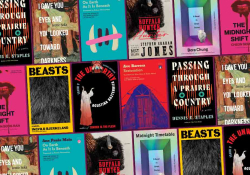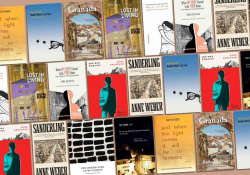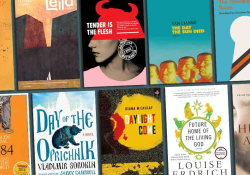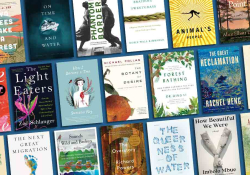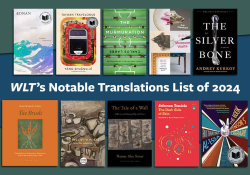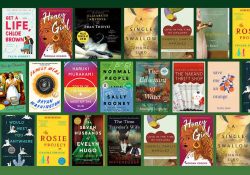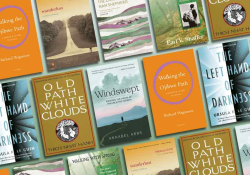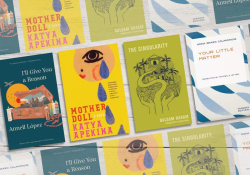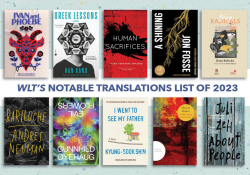100 Issues in 20 Years: A Top 10 List (2002–2022)
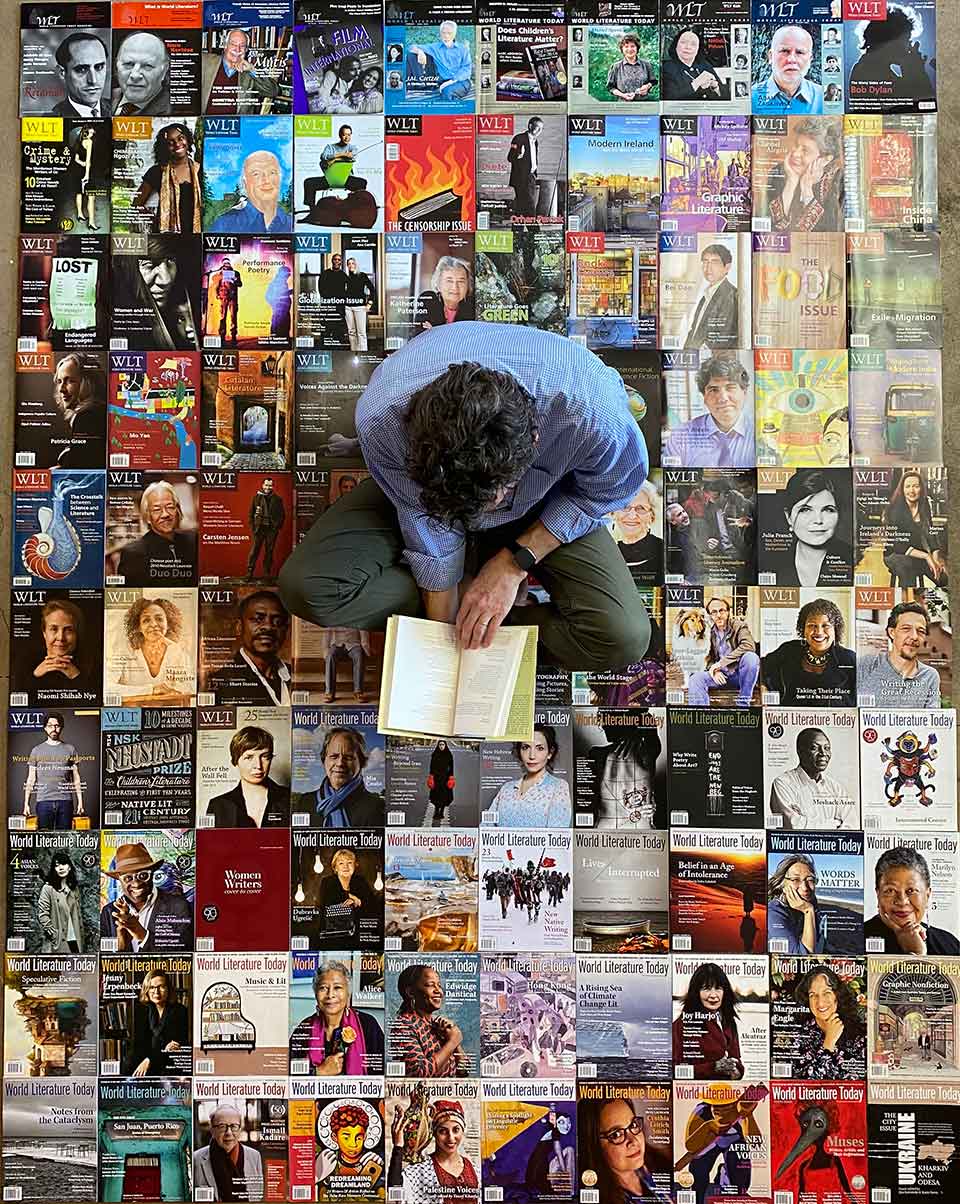
In his poem called “The Man on the Dump” (1938), Wallace Stevens writes: “Days pass like papers from a press.” Stevens, who was in his late fifties when he wrote the poem on the eve of World War II, turns it into a surprisingly philosophical meditation, given the subject matter: one of the poem’s supreme ironies is that much of the text’s surface catalogs the detritus the author might have found strewn about the local landfill in Hartford, Connecticut. The narrator, like a grackle, takes delight in whatever catches his roving eye: withered bouquets, corsets, “an old tin can, lard pail,” “mattresses of the dead,” and so on. Ultimately, the poem questions whether the art we make can suffice when weighed against the entropies of time.
With the July 2022 issue and its Ukraine cover feature, I’ve had the privilege of working on 100 issues of WLT over the past 20 years, and I’ve often thought of Stevens’s line as the alliterative equivalent of an offset printer that keeps clacking and churning, measuring the quotidian swirl of communication (faxes and letters, emails, phone calls, Zoom chats, and Slack messages), collaboration (editorial brainstorming, copyediting and proofreading, design challenges), budgets and production deadlines, literary festivals and writers’ conferences, grammar and grand ideas. “Days pass like papers from a press” is an apt simile, yet it strikes me that as time passes—more than 7,000 days since 2002, and nearly 9,000 magazine pages across those 100 issues—the ebb and flow of that work, in retrospect, resembles a novel more than a poem, seems more Proustian than Stevensian, I suppose. (Unfortunately, Proust died before the publication of the final three volumes of In Search of Lost Time, a fate I hope to avoid during my tenure at WLT.) After a series of epiphanies in Time Regained (1927), the final volume of Proust’s masterpiece, his narrator comes to see the flowingness and iridescence of a Fortuny gown as the figure of temporal flux through which art offers a glimpse of eternity.
In the spirit of Stevens’s grackle and Proust’s Fortuny gown, then, and by way of celebrating the milestone of 100 issues, I’d like to reflect on 10 of my favorites.
* * *
Adam Zagajewski
Meeting Neustadt Prize laureate Adam Zagajewski in 2004, when he visited the University of Oklahoma to accept the award, remains one of the highlights of my publishing career. Working on the May 2005 issue, which pays tribute to his life and work, also served as a sobering reminder: the task of proofreading is never done. I was mortified to find out that, after the issue had been printed and distributed, the final stanza of his poem “Walk through This City,” in Clare Cavanagh’s translation, had been chopped off. (We reprinted the entire poem in a subsequent issue.) There’s always a trade-off between time and perfection, and time inevitably wins.
Mo Yan
With the July 2009 issue, I assumed the helm as WLT’s editor in chief after serving as managing editor since 2002 and acting editor in chief since 2008. In my editor’s note introducing the issue, I pay tribute to the nine editors who have preceded me, along with the many OU colleagues, editorial board members, benefactors, dedicated WLT staff, and the countless writers, artists, and scholars who helped make WLT what it is today: “A palimpsest filled with the trace of thousands of words on the printed page, and behind those words the voices of authors who have defined the literatures of the twentieth and twenty-first centuries.”
Poetry Untethered
For the September 2011 issue, with its compelling cover art by Jen Blair, we decided to group the ten poets gathered in the issue’s cover feature under the “Poetry Untethered” rubric as a gesture toward the loosening of geographies, temporalities, and tongues to be found in their work. At the same time, a unifying thread marks the poets’ sense of the possibilities of English-language verse a decade after 9/11. “The horizon of black lines on the white page—with their Penelope-like return to the left-hand margin after every line break—anchors these poems,” I wrote, “keeping them in the mind’s eye, and ear, even as they tempt us with arcs of transcendence.”
Photography: Taking Pictures, Telling Stories
Early on during my tenure at WLT, I had the pleasure of meeting Yousef Khanfar, the award-winning writer and photographer who has been honored by the Palestine mission to the United Nations for “appreciation of his extraordinary service to promoting peace and justice in Palestine through art.” For several years, Yousef and I discussed the idea of devoting an issue of WLT to photography. The result? The stunning 160-page March 2013 double issue, supported by the National Endowment for the Arts, that presents photo-essays by twenty-one world-class photographers inside. On the cover, we decided to feature Phil Borges’s photo from Tibet of twelve-year-old Tensin Yeshi, plus his “Tibet: Culture on the Edge” essay inside; we also brought Phil’s Stirring the Fire exhibition to OU’s Fred Jones Jr. Museum of Art that spring, along with Ethiopian writer Maaza Mengiste as our 2013 Puterbaugh Fellow, to take part in the “Image and Word” festival. The festival, with its theme of women’s empowerment, also included the Oklahoma premiere of the film Girl Rising. More recently, Yousef and I collaborated on the “Palestine Voices” issue, another high-water mark in the magazine’s recent history.
After the Wall Fell
The November 2014 issue highlights central European literature from 1989 to 2014, marking the twenty-fifth anniversary of the fall of the Berlin Wall. Writers from a dozen countries survey the landscape after what German poet Durs Grünbein called “a mass collision of historical proportions.” As part of the issue, we published the results of our “25 Books That Inspired the World” poll, for which the editors invited twenty-five writers to nominate one book—written in any language and published since November 1989—that most influenced their own writing or ways of seeing the world. The longlist was then published on WLT’s blog, and readers were invited to vote for their three favorites. More recent polls have been devoted to “21 Books for the 21st Century” and literary activism during the fifty years following the occupation of Alcatraz (1969–2019).
Art Poetry
The headline section of the November 2015 issue, guest-edited by Lauren Camp and with dramatic cover art by Australian artist Fiona Hall, combines two of my favorite genres: poetry and visual art. In particular, the poetry in the issue belongs to that realm of verbal art known as ekphrasis, which takes its cues from painting, sculpture, photography, or other visual media and transmutes them into a new verbal form. One of my favorite poems in the issue, “Resurrection,” by Uruguayan writer Circe Maia, responds to Remedios Varo’s 1963 painting Naturaleza muerta resucitando (Still Life Revived), with a concluding stanza that reads: “These things were declared / dead, but they are not. / Or perhaps yes, they were dead / and the painting has resurrected them, made them / rise up, turning / as if moved by an invisible wind.” That possibility of resurrection animates every work of art that wrestles with our mortality.
Belief in an Age of Intolerance
For the November 2017 issue, I traveled to Andrews Hall at the University of Nebraska, where I had the pleasure of sitting down with former US Poet Laureate Ted Kooser to discuss poetry, belief, and tolerance. In our wide-ranging conversation, Kooser touches on the emotional center of his work (his grandparents’ place near Guttenberg, Iowa, a few hundred yards from the banks of the Mississippi); the genius of metaphor; seeking order amidst the chaos of his cancer diagnosis; observation as a form of reverence; poetry, painting, and the consolations of art. In response to my question about tolerance, he mentions the concept of tolerance in physics, then says: “What I might say is that I see writing poems and painting pictures as being affirmations of life.” In a time of so much intolerance, such affirmations of the fundamental human relationships that tie us one to another also serve as a reminder of the power of great writing to invest those ties with deeper meaning.
A Rising Sea of Climate Change Lit
WLT’s Summer 2019 issue followed up our dossiers devoted to environmental literature in July 2008 and May 2014. The latter issue includes two poems by Niyi Osundare that have received over 25,000 views on our website in the past five years. More recently, eco-poems by two writers from the Philippines—Rina Garcia Chua and Marjorie Evasco—have received over 60,000 views during that same time period. Something about this work from the Global South clearly strikes a chord among our readers. In the Summer 2019 issue, I preface my editor’s note with an epigraph by Kathleen Dean Moore: “If one were to drive a nail through this decade, planetary history would swing in the balance.” Moore wrote that sentence eight years ago, and the nail driven through the 2010s has become, in the 2020s, even more tenuous due to the pendulum swings of climate catastrophe. Just last week, the proposed Inflation Reduction Act of 2022 offered a glimmer of hope that the US might finally take decisive action to meet the minimum action steps outlined in the latest Sixth Assessment Report from the IPCC. One of the highlights of the issue is Pireeni Sundaralingam’s “A Clarion Call to Action” booklist of nine essential titles on the subject; undoubtedly, writers and artists will continue to make common cause with scientists and activists who envision a future other than collapse and extinction.
Redreaming Dreamland
The Spring 2021 “Redreaming Dreamland” issue gathers the work of twenty-one writers and artists reflecting on the centennial of the 1921 Tulsa Race Massacre, including Patricia Smith, Joy Harjo, Jewell Parker Rhodes, and Tracy K. Smith. The immediate impetus for the project began in January 2019, when a student-led rally at the Oklahoma Memorial Union ignited a long-simmering conversation about diversity, inclusion, and racial equity at the University of Oklahoma. Immediately afterward, I reached out to my colleague Karlos Hill, chair of OU’s Clara Luper Department of African & African American Studies, to thank him for offering words of witness, solidarity, and historical memory at the rally. I also broached with him the idea of a special issue of WLT, to coincide with the centennial of the massacre, featuring writers and artists reflecting on the anniversary but with equal emphasis on the current state of African American multicultural vitality in the twenty-first century, anchored in Oklahoma yet rippling out on a global scale. He immediately and enthusiastically agreed to the idea.
The Spring 2021 issue was but one result of that conversation, which began in earnest in 2019 but was also amplified in summer 2020, when demonstrations following the murder of George Floyd erupted worldwide. Dr. Hill and I along with our colleague Kalenda Eaton formed a committee to coordinate a yearlong series of more than two dozen courses, special projects, and events devoted to the centennial across OU’s three campuses in Norman, Tulsa, and Oklahoma City, culminating in the three-day “Reflecting on the Past, Facing the Future” symposium in April 2021. Recent US Poet Laureate Tracy K. Smith gave the keynote talk for the symposium, which also included the world premiere of the I Dream of Greenwood dance film and culminated in a Zoom event hosted by Tulsa’s Fulton Street Books that drew more than a thousand attendees. I still consider “Redreaming Dreamland” the most important issue I’ve ever worked on.
Muses: Writers, Artists, and Their Inspirations
Rembrandt, Kandinsky, and Wyeth are some of the most famous artists whose works inspire the writers featured in the May 2022 issue, but my favorite pieces are by Oklahoma artist Holly Wilson (Delaware/Cherokee): Girl in the Red Dress (2019), on the cover, and Carried in the Wind (2019) on the opening spread of the cover feature. In the artist statement on her website, Wilson writes: “Narrative is central to my work. I am interested in stories—the stories of my parents, my ancestors, my family, my community. I am a storyteller; through my work, I weave together the threads of these various narratives to create a tapestry that tells stories that are sacred and precious, personal and universal, powerful and at times volatile.” Drawing on the connections that Gayle Curry, WLT’s art director (and herself an artist), has with artists in central Oklahoma and beyond, we’ve also featured the work of local artists Ebony Iman Dallas and Denise Duong on recent covers, along with numerous author portraits by Norman-based photographer Shevaun Williams.
* * *
Special thanks to the colleagues who have made the past twenty years the most rewarding journey of my professional life: Merleyn Ruth Bell, Jen Rickard Blair, Kay Blunck, David Draper Clark, Gayle Curry, RC Davis-Undiano, Marla Johnson, Michelle Johnson, Terri Stubblefield, Victoria Vaughn, and Rob Vollmar.
And to my wife and daughters: thank you for your love, your humor, and your patience while I “fix commas” all day.
University of Oklahoma

